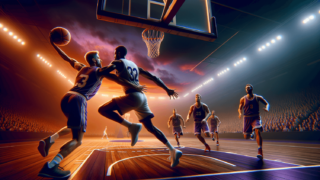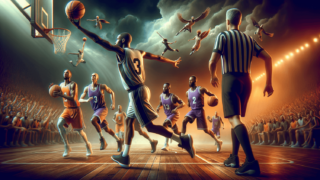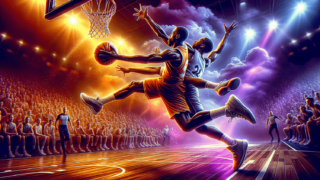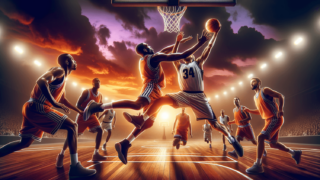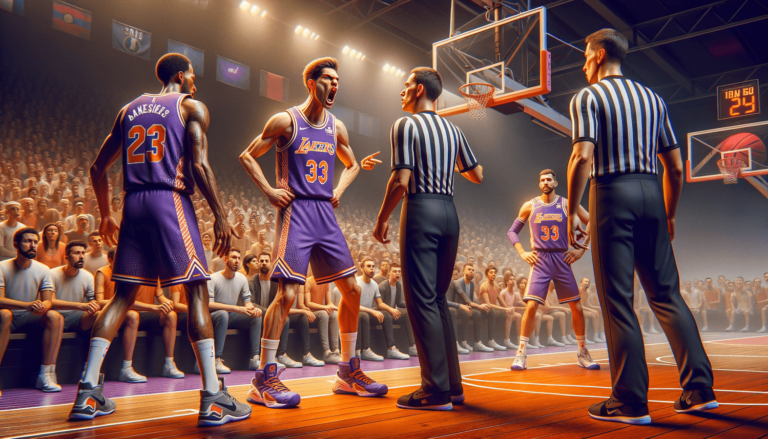
Double Technical Foul Rule in Basketball
Written by: Basketball Universe
Last updated:

Calling all roundball lovers, gather ’round! 🏀 In the riveting world of basketball, diverse plays, emotions, and rulings intertwine to create memorable games that impact history. One such aspect is the double technical foul rule – a perfect blend of discipline and intrigue. In this blog post, we’ll bounce our way through spats between players and indisputable tensions between players and refs, all while breaking down the ramifications of the enigmatic double technical foul rule. With knowledge as our playbook, we’ll sink all the crucial shots to help you become an all-around basketball expert!
Double Technical Foul Rule in Basketball
The double technical foul rule in basketball refers to when both opposing players or team representatives receive technical fouls due to unsportsmanlike actions or conduct that occurs simultaneously or in quick succession. This can involve verbal altercations, physical confrontations, or gestures that violate the standards of sportsmanship. In such cases, both teams are assessed a technical foul without any free throws being awarded, and the game resumes with a jump ball or a throw-in, depending on the specific circumstances. The technical fouls count toward the players’ and team’s foul limits.
Jump into the Realm of Technical FoulsBefore we dive into the double technical foul rule, let’s lay the groundwork by understanding what a technical foul is in the context of basketball. A technical foul, as defined by the NBA and FIBA, occurs when a player or team’s representative engages in unsportsmanlike conduct or violates the rules that don’t involve physical contact with an opponent. Technical fouls can result from a myriad of actions, such as abusive language, taunting, excessive timeouts or substitutions, and inappropriate gestures. They can also involve coaches, who can be penalized for arguing calls or stepping out of the designated coaching box.
Double Trouble: The Double Technical Foul Rule
Now that we understand the foundation of technical fouls, let’s explore the double technical foul rule. As mentioned earlier, this unique situation arises when both opposing players or representatives receive technical fouls for their conduct, either happening simultaneously or in immediate succession. To keep the game fair and engaging, the double technical foul rule disincentivizes such behavior and ensures that neither team garners an advantage.
Basketball Rules and Consequences
Awareness of the consequences of double technical fouls can deter players from engaging in unsportsmanlike behavior. In this section, we’ll break down the implications of the double technical foul rule and the situations where it comes into play.
Team Fouls and Limits
When a double technical foul occurs, both teams receive a technical foul. These fouls count toward a team’s overall foul limit, which is crucial when it comes to penalty situations. After exceeding the limit, teams will be penalized by awarding their opponents free throws. NBA and NCAA games have slightly different rules regarding team foul limits, so be sure to familiarize yourself with both sets of guidelines if you’d like to have a comprehensive understanding.
Player Fouls and Ejections
Double technical fouls also impact individual players. When a player is assessed a technical foul, it counts toward their total number of personal fouls. NBA players are allowed six personal fouls per game, whereas NCAA players are allowed five. Once a player has reached their foul limit, they are ejected. Furthermore, players can be ejected after receiving two technical fouls in the same game, regardless of their cumulative personal foul count. So, it goes without saying that it’s crucial for players to avoid getting caught up in the heat of the moment!
Resuming Play after a Double Technical Foul
After referees have sufficiently dealt with a double technical foul, it’s time to resume the game. However, the method of resumption depends on the specific scenario within which the double technical foul transpires.
Jump Ball Situations
In situations where the double technical foul occurs during a dead ball or after a made basket, the game resumes with a jump ball. A jump ball involves tossing the ball into the air by a referee between two opposing players, who then try to tip it to their teammates to gain possession. The team that last won a jump ball remains with the possession arrow when the ball is tossed. According to NBA rules, if a double technical foul occurs during an initial jump ball, the wheelchair-bound official – also known as the umpire – can conduct a new jump ball.
Throw-in Situations
If the double technical fouls are assessed during live gameplay, the game resumes with a throw-in. To maintain fairness, the team in possession of the ball before the fouls keeps possession. The throw-in occurs at the nearest sideline, on the side of the court where play was halted due to the double technical foul.
Prominent Double Technical Foul Incidents: Lessons from the Stars
As avid basketball fans, we’ve seen some unforgettable instances of double technical fouls that have led to fines, ejections, and even suspensions. Let’s take a look at some of those famous incidents and analyze what we can learn from them.
The Malice at the Palace
One of the most infamous brawls in NBA history occurred on November 19, 2004, between the Indiana Pacers and the Detroit Pistons. The altercation began when a hard foul escalated to a full-blown brawl, involving both players and fans. Multiple double technical fouls were assessed, followed by a total of nine players getting suspended for varying durations. This cautionary tale underscores the importance of sportsmanship, and the need for players to prioritize fair play over heated emotions.
Technical Fouls and Trash Talking: The Art of (Mis) Communication
In close matchups, spirited and competitive exchanges between players are inevitable. However, trash talking can sometimes cross the line and result in double technical fouls. While emotions run high in heated contests, players must always remember to never jeopardize their teams’ success by engaging in unsportsmanlike conduct.
Clever Coaching, Disruptive Tactics
While coaching plays a pivotal role in guiding a team to victory, there are times when the coaches, too, find themselves in hot water. Some coaches willingly risk being assessed a double technical foul as a strategic move, hoping to disrupt the flow of the game and demoralize their opponents. However, this course of action may backfire, leading to the coach’s ejection or yielding no positive results for their team. As a coach, it is important to avoid tarnishing the spirit of the game with such questionable tactics.
Navigating Double Technical Fouls in Amateur Basketball
For amateur players, understanding the double technical foul rule is crucial for individual growth and maintaining team dynamics. Here are some pointers to help develop strong habits that prevent double technical fouls from rearing their ugly heads.
Keeping Composure Under Pressure
Whether you’re playing in a close game, a high-stakes tournament, or a casual pickup match, maintaining composure is vital. When players lose their cool, the entire game can spiral out of control, with double technical fouls being just one of the potential consequences. By staying composed under pressure, you promote fair play and exhibit sportsmanship, which will ultimately serve you and your team best.
Staying Focused on the Game
Keeping your focus solely on the game allows you to avoid getting embroiled in distractions, potential arguments or conflicts, and, thus, double technical fouls. A laser-like focus not only prevents penalties but also enhances decision-making and reaction times on the court.
Effective Communication
Excellent communication is vital to keeping tempers in check and fostering synergy on the court. By communicating effectively with your teammates, you reinforce trust, diffuse conflicts before they escalate, and create a team dynamic that supports sportsmanship and success.
With these insights and strategies in mind, you’re now equipped to become a true basketball aficionado, appreciating the nuances of the double technical foul rule and applying the lessons learned to your own game. Remember, knowledge is power – and in the world of basketball, it can be the difference between a game-winning shot and a technical knockout!
Preventing Double Technical Fouls: Referees’ Vital Role
Besides the players and coaches, referees play a crucial part in preventing double technical fouls and maintaining the integrity of the game. By understanding the referee’s role, you can identify when and how they employ preventative measures to keep the game running smoothly and without disruptions.
Setting the Tone
Referees must establish their presence and authority from the onset of the game, ensuring that all participants adhere to fair play and sportsmanship. By setting the tone, referees minimize the chances of confrontations escalating to the point of necessitating double technical fouls or any other penalties.
Conflict Resolution
In the heat of the moment, conflicts may arise between opposing players or team representatives. A referee’s responsibility is to intervene and defuse the situation before it can escalate. This conflict resolution skill enables them to maintain order and harmony on the court, further reducing the likelihood of double technical fouls being assessed.
Keeping a Close Eye on the Game
While monitoring the game, referees are trained to anticipate potential conflicts and swiftly react to incidents that might result in altercations or double technical fouls. Through their vigilance, referees can preemptively address and neutralize situations that might otherwise disrupt the game or negatively impact its outcome.
Cultivating Sportsmanship: Going Beyond the Double Technical Foul Rule
As a final takeaway, let’s emphasize the importance of instilling sportsmanship and fair play by stepping away from a narrow focus on technical fouls. By going beyond that, we can contribute to the overall spirit of the game in a positive way.
Respecting Opponents
Respecting your opponents means recognizing their skills, achievements, and efforts in the game. Giving respect will not only encourage fair play but also foster a sense of camaraderie and mutual appreciation among competitors, thereby reducing the chances of double technical fouls or other negative incidents.
Appreciating Teammates
Teamwork and mutual support are fundamental in basketball. Showing appreciation for your teammates, their hard work, and their contributions to the team’s success encourages a positive atmosphere on and off the court. This approach minimizes the chances of conflicts, confrontations, and technical fouls, helping to create a stronger team experience overall.
Continuous Personal Development
A commitment to personal development, both on and off the court, involves enhancing your basketball skills, emotional intelligence, and communication abilities. Dedicating yourself to self-improvement can help reduce the chances of being involved in incidents that result in double technical fouls or contribute to a toxic environment in the sporting arena.
By incorporating these principles and values, you’ll become not only a well-rounded basketball player but also someone who exemplifies the game’s spirit, contributes to a healthy competitive environment, and safeguards the joy and passion of basketball for all.
FAQ: Double Technical Fouls Demystified
For those seeking to enhance their understanding of the double technical foul rule in basketball, we have compiled a list of frequently asked questions (FAQs) with NLP-style answers. Delve into these questions to further enrich your knowledge on this intriguing aspect of basketball rules.
1. What is a technical foul in basketball?
A technical foul is a penalty called for unsportsmanlike actions or violations that don’t involve physical contact with an opponent. These actions can include abusive language, taunting, excessive timeouts, or inappropriate gestures, and can involve both players and team representatives.
2. What constitutes a double technical foul?
A double technical foul occurs when both opposing players or team representatives receive technical fouls due to their unsportsmanlike conduct that transpires simultaneously or in immediate succession. This can include verbal altercations, physical confrontations, or gestures violating sportsmanship standards.
3. Do double technical fouls result in free throws?
No, when double technical fouls are assessed, both teams receive a technical foul, but no free throws are awarded. This ensures that neither team gains an advantage from the incident.
4. How does a double technical foul affect a player’s personal foul limit?
When a player is assessed a technical foul, it counts toward their total personal fouls. NBA players are allowed six personal fouls per game, while NCAA players are granted five. Once a player reaches their limit, they are ejected.
5. How are double technical fouls handled in amateur basketball?
Double technical fouls are essentially handled the same way in amateur basketball as in professional leagues, with both teams receiving technical fouls and officials addressing the situation before resuming the game. However, the specific rules for team and personal foul limits may vary across different amateur leagues and age groups.
6. How is gameplay resumed after a double technical foul?
After a double technical foul situation, play resumes either with a jump ball or a throw-in, depending on the specific circumstances. In dead ball situations, a jump ball is used, while in live gameplay situations, the game resumes with a throw-in.
7. How can a player avoid receiving a technical foul?
To avoid receiving a technical foul, a player should maintain composure, focus on the game, and communicate effectively with their teammates. This not only prevents penalties but also enhances team dynamics and decision-making on the court.
8. What role do referees play in preventing double technical fouls?
Referees play a vital role in preventing double technical fouls by setting the tone of the game, intervening and resolving conflicts, and closely monitoring the game for potential incidents. Their authority and presence help maintain the order and integrity of the game.
9. What can coaches do to prevent double technical fouls?
Coaches can prevent double technical fouls by fostering a culture of sportsmanship, emphasizing the importance of fair play, and guiding their teams in effectively communicating both on and off the court. They also have a responsibility to set an example by exhibiting professionalism and restraint in their conduct.
10. How can the spirit of sportsmanship contribute to preventing double technical fouls?
The spirit of sportsmanship emphasizes mutual respect, fair play, and appreciation for one’s teammates and opponents. By instilling these values, players and team representatives can minimize conflicts and confrontations, effectively reducing the chances of double technical fouls or other unsportsmanlike incidents.
Featured Posts
- No pillar pages found.
